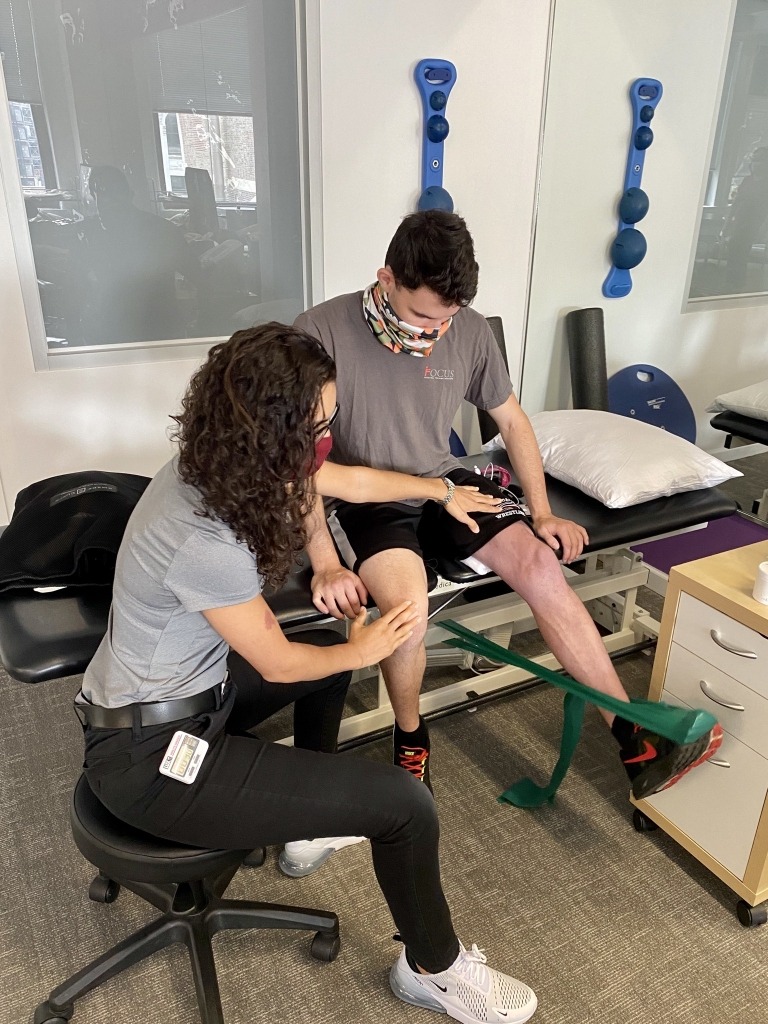What is Blood Flow Restriction (BFR) training and how does it work?
Blood Flow Restriction (BFR) training involves using a medical tourniquet/cuff which partially restricts blood flow while exercising. I know this sounds scary, but keep reading! The cuff is wrapped around the upper arm (below the shoulder) or lower leg (below the hip). It is then inflated to a specific pressure to obtain partial arterial blood flow and complete venous occlusion. Meaning, blood is still able to flow to your muscles! This is actually a natural state for your body to be in and happens when you are exercising. Contracting muscles requires large amounts of oxygen and blood to continue to be able to work. BFR allows for more blood to flow to the muscles, forcing your muscles to work harder without adding the stress of using heavy weights. This is perfect for people who have joint pain! Using BFR allows for a low intensity exercise program that produces similar results to high intensity training. It has been used in gym and training settings for some time now but it is increasingly gaining popularity in clinical settings such as physical therapy rehabilitation.
Is BFR safe?
BFR is safe when done with the proper equipment and under the supervision of a trained and certified individual. However, it is not for everyone. Patients possibly at risk of adverse reactions are those with poor circulatory systems, diabetes, and/or severe hypertension. BFR is not for patients who have a history of blood clots (deep vein thrombosis or pulmonary embolism), sickle cell anemia, extremity infection, open fracture/wounds, cancer or tumors, poor blood flow, or anyone who is pregnant.
What are the benefits of BFR?
- Strength – Muscle hypertrophy (increase in muscle size) can be observed during BFR training within a 3-week period. When training with BFR, you are performing resistance exercises at a low intensity, using 20-30% of the weight you usually use (max weight), with high repetitions per set (15-30) and short rest intervals between sets (30-60 seconds).
- Aerobic Training – BFR can be applied during an aerobic exercise such as walking or cycling. BFR has shown to increase cardiovascular endurance.
- No Exercise – BFR can be applied passively (without exercise) and has shown positive results in reducing muscle atrophy (wasting).
Who can benefit from BFR?
- The Athlete – BFR gives the “extra boost” needed when athletes have maxed out of their typical routine. Athletes can use BFR as an “active recovery day” especially on non-training days to continue to see gains. Athletes can also benefit from BFR via faster recovery of muscle hypertrophy and cardiovascular endurance if suffering from an injury and/or post-operative surgery i.e. Knee arthroscopy, ACL repair, Rotator cuff repair.
- Anyone who is suffering from an injury or is in the pre/post-surgery phase – BFR provides an increase in endurance and muscle strength without putting mechanical stress on a healing muscle or joint. BFR is even used on patients who are non-weight bearing due to a fracture and is used to prevent any further loss of muscle due to lack of activity, injury or being post-surgery. Using BFR pre-surgery helps to reduce muscular loss, which is a very common occurrence after orthopedic surgeries.
- Senior Population – BFR helps to improve generalized weakness and allows patients to maximize muscle strength and endurance using low weights at low impact. Senior patients who are unsteady on their feet due to balance and strength issues can also benefit from this greatly.

If you are interested in finding out more or trying out BFR training, please reach out!
In good health,
References:
- VanWye WR, Weatherholt AM, Mikesky AE. Blood flow restriction training: Implementation into clinical practice. International journal of exercise science. 2017;10(5):649.
- Pope ZK, Willardson JM, Schoenfeld BJ. Exercise and blood flow restriction. The Journal of Strength & Conditioning Research. 2013 Oct 1;27(10):2914-26.
- Wideman L, Weltman JY, Hartman ML, Veldhuis JD, Weltman A. Growth hormone release during acute and chronic aerobic and resistance exercise. Sports medicine. 2002 Dec 1;32(15):987-1004.
- Wilson JM, Lowery RP, Joy JM, Loenneke JP, Naimo MA. Practical blood flow restriction training increases acute determinants of hypertrophy without increasing indices of muscle damage. The Journal of Strength & Conditioning Research. 2013 Nov 1;27(11):3068-75.
- Sousa, Jbc et al. “Effects of strength training with blood flow restriction on torque, muscle activation and local muscular endurance in healthy subjects.” Biology of sport vol. 34,1 (2016): 83-90. doi:10.5114/biolsport.2017.63738
- Lowery RP, Joy JM, Loenneke JP, de Souza EO, Machado M, Dudeck JE, Wilson JM. Practical blood flow restriction training increases muscle hypertrophy during a periodized resistance training programme. Clinical physiology and functional imaging. 2014 Jul;34(4):317-21.
- PICÓN MM, CHULVI IM, CORTELL JM, Tortosa J, Alkhadar Y, Sanchís J, Laurentino G. Acute cardiovascular responses after a single bout of blood flow restriction training. International Journal of Exercise Science. 2018;11(2):20.
#teamcynergy #physicaltherapy #bfr #bloodflowrestriction #sports #sportsperformance #getmovingkeepmoving #sportsinjuryrehab #strengthandconditioning #injuryprevention #clinicalathlete #functionalmovement #nike #getpt1st #sportsrehab #physiotherapy #physicaltherapynyc #equinox #acl #aclrecovery #chooseptfirst #we💜healingourpatients #cynergyphysicaltherapy #nyc
